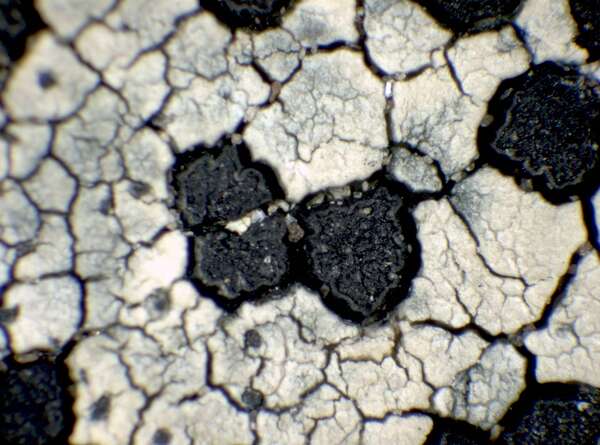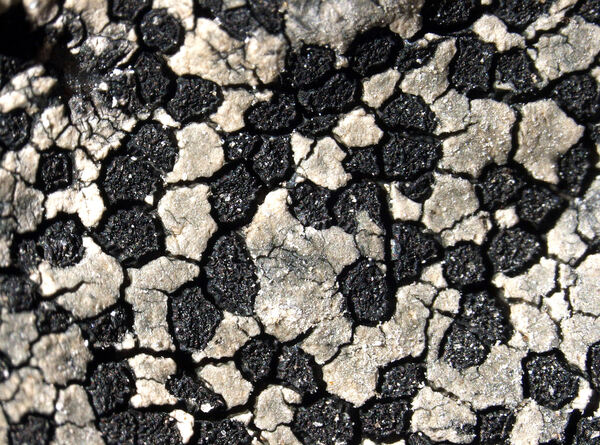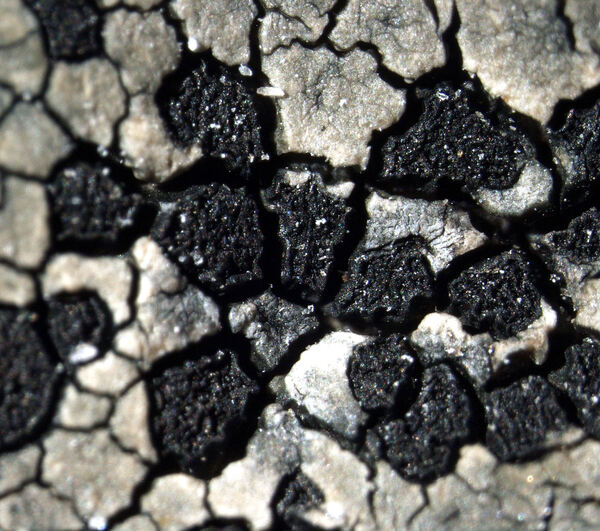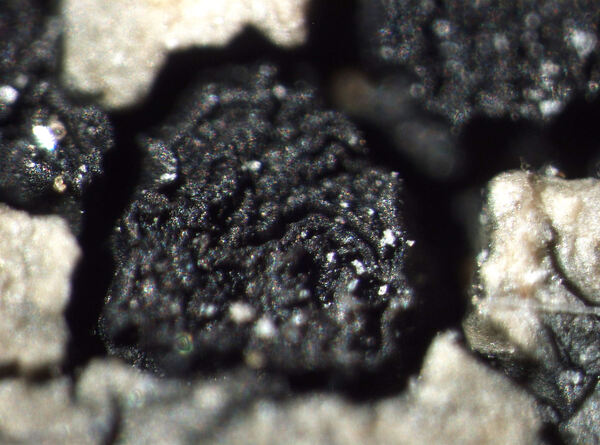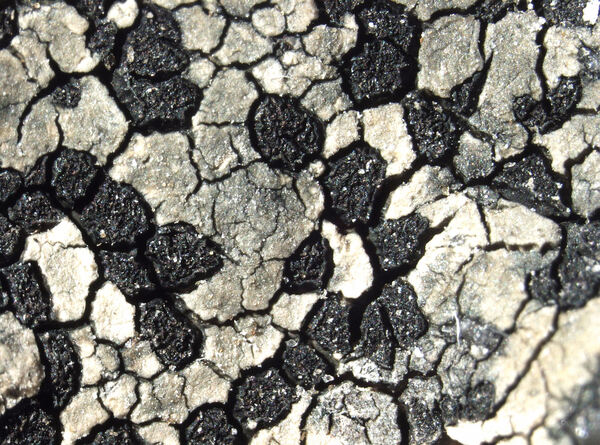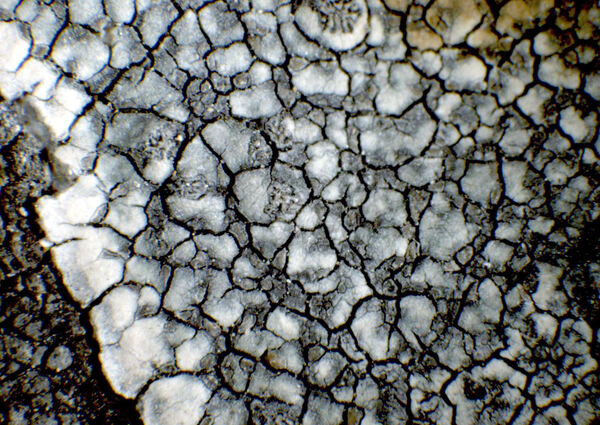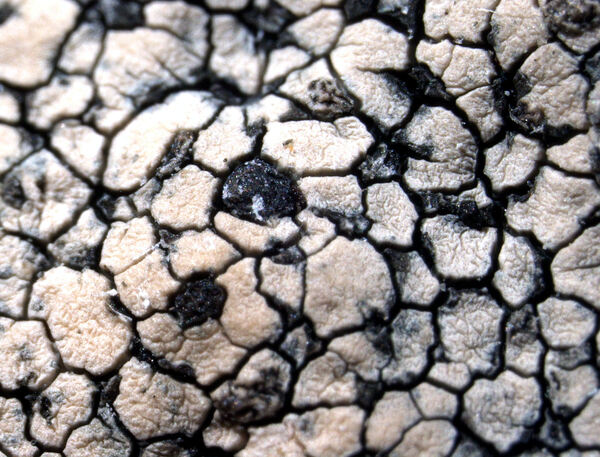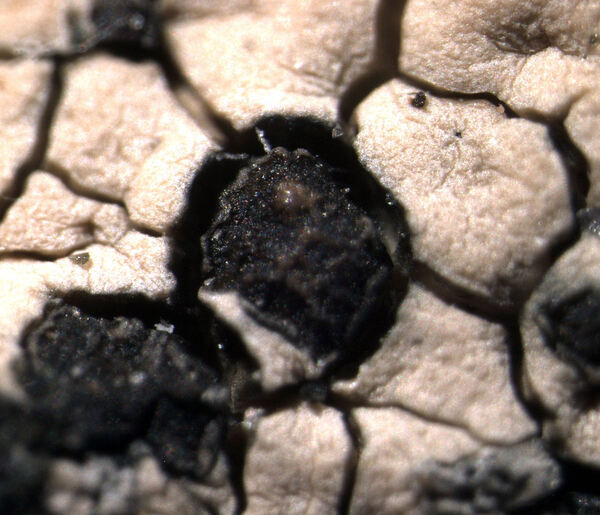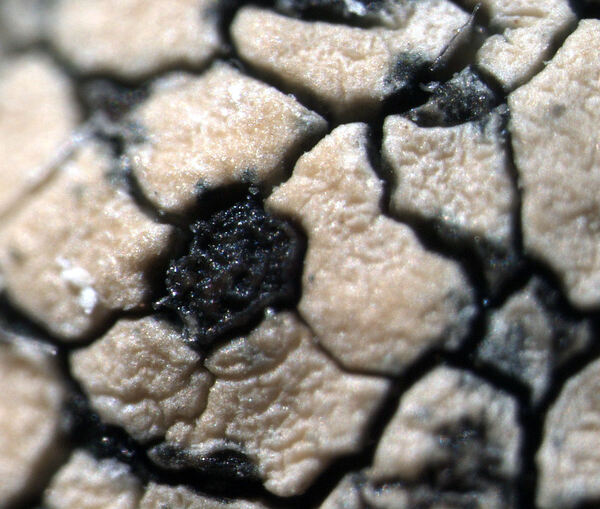Sporastatia polyspora (Nyl.) Grummann
Cat. Lich. Germ.: 23, 1963. Basionym: Gyrothecium polysporum Nyl. - Essai Nouv. Classif. Lich.: 186, 1854.
Synonyms: Biatorella cinerea (Schaer.) Th. Fr.; Lecidea morio var. cinerea Schaer.; Lecidea nigrocinerea Nyl.; Sporastatia cinerea (Schaer.) Körb.; Sporastatia morio var. cinerea (Schaer.) Körb.
Description: Thallus crustose, episubstratic, areolate, pale bluish grey to yellowish grey in peripheral parts, dull, forming up to 8(-12) cm wide patches, delimited by a more or less evident black prothallus. Areoles to 0.6(-1) mm wide and to 0.4 mm thick, round to angular, flat to slightly convex, the peripheral ones usually weakly elongate. Cortex 25-50 μm thick, dark olive-brown in upper part, of more or less vertically arranged hyphae, covered with a thin, colourless epinecral layer; algal layer continuous; medulla grey, with granules, I-. Apothecia lecideine, black, angular in outline, (0.2-)0.4-0.8(-1.2) mm across, level with the areoles, separated from the thallus by a crack, with a flat to slightly convex, very uneven, often cracked disc and a thin, raised, cracked-uneven proper margin. Proper exciple carbonaceous, c. 10 μm thick, K+ reddish; epithecium pale to dark blue-green or olive-brown, K+ reddish, N+ red; hymenium colourless, 60-115 μm high, I+ deep blue; paraphyses 1.7-2 μm thick at mid-level, the apical cells 2.5-3 μm wide; hypothecium pale brownish grey, 35-50 μm thick, I+ blue. Asci 150-250-spored, broadly clavate, the apical dome uniformly K/I+ blue. Ascospores 1-celled, hyaline, subglobose, (2.5-)3-4 x 2-4(-4.5) μm. Photobiont chlorococcoid. Spot tests: cortex and medulla K-, C+ red, KC+ red, P-. Chemistry (Øvstedal & al. 2009, Hafellner & al. 2014, Obermayer in litt.): 5-O-methylhiascic acid (major), gyrophoric acid (trace).
Growth form: Crustose
Substrata: rocks
Photobiont: green algae other than Trentepohlia
Reproductive strategy: mainly sexual
In underhangs rarely wetted by rain
Commonnes-rarity: (info)
Alpine belt: very common
Subalpine belt: common
Montane belt: absent
Dry submediterranean belt: absent
Humid submediterranean belt: absent
Padanian area: absent
pH of the substrata:
1 2 3 4 5
Solar irradiation:
1 2 3 4 5
Aridity:
1 2 3 4 5
Eutrophication:
1 2 3 4 5
Poleotolerance:
0 1 2 3
Altitudinal distribution:
1 2 3 4 5 6
Rarity
absent
extremely rare
very rare
rare
rather rare
rather common
common
very common
extremely common
Loading data...
Occurrence data
Predictive map
Growth form: Crustose
Substrata: rocks
Photobiont: green algae other than Trentepohlia
Reproductive strategy: mainly sexual
In underhangs rarely wetted by rain
Commonnes-rarity: (info)
Alpine belt: very common
Subalpine belt: common
Montane belt: absent
Dry submediterranean belt: absent
Humid submediterranean belt: absent
Padanian area: absent
pH of the substrata:
| 1 | 2 | 3 | 4 | 5 |
Solar irradiation:
| 1 | 2 | 3 | 4 | 5 |
Aridity:
| 1 | 2 | 3 | 4 | 5 |
Eutrophication:
| 1 | 2 | 3 | 4 | 5 |
Poleotolerance:
| 0 | 1 | 2 | 3 |
Altitudinal distribution:
| 1 | 2 | 3 | 4 | 5 | 6 |
Rarity
absent
extremely rare
very rare
rare
rather rare
rather common
common
very common
extremely common
Loading data...
Occurrence data
Predictive map


